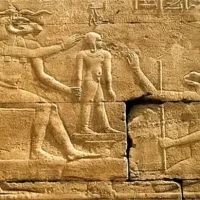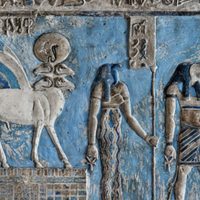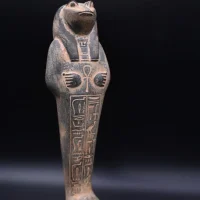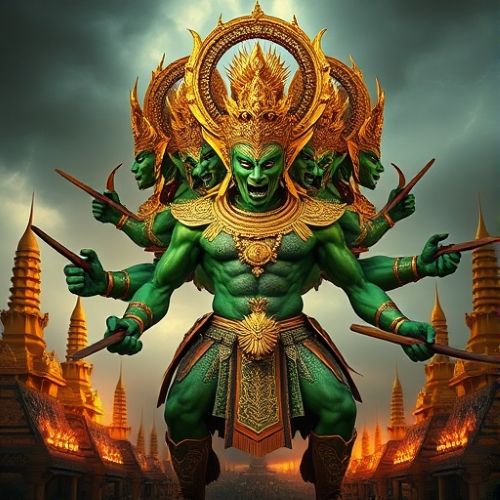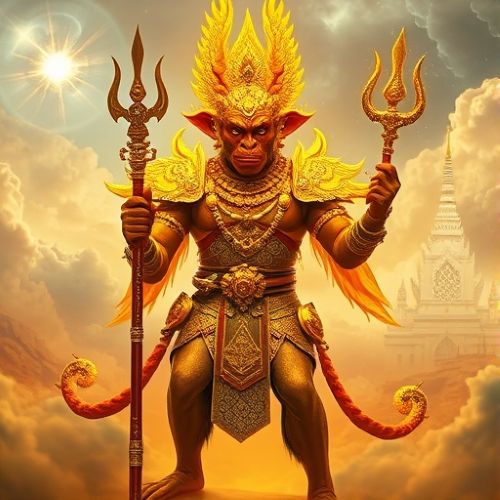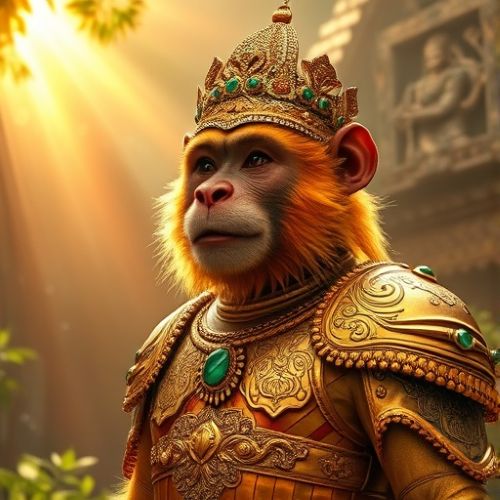Phra Phiphek : The Wise Demon King of Righteousness
Listen
At a glance
| Description | |
|---|---|
| Origin | Thai Mythology |
| Classification | Demigods |
| Family Members | Thotsakan, Kumbhakan (Brothers), Trichada (Wife), Benjakay (Daughter) |
| Region | Thailand |
| Associated With | Wisdom, Virtue, Morality, Royalty |
Phra Phiphek
Introduction
Phra Phiphek, known as one of the most remarkable figures in Thai mythology, embodies the timeless struggle between familial loyalty and moral duty. Featured prominently in the Ramakien, the Thai adaptation of the Ramayana, Phra Phiphek (derived from the Sanskrit Vibhishana) is portrayed as a demon prince whose wisdom and devotion to righteousness make him one of the most respected yaksha in Southeast Asian mythology. Unlike his brother Thotsakan (Ravana), the tyrannical ruler of Longka, Phra Phiphek chose virtue over kinship, aligning himself with Phra Ram (Rama), the embodiment of dharma. His journey from exile to kingship represents the victory of morality, foresight, and wisdom over chaos and pride.
Physical Traits
In traditional Thai art and Khon performances, Phra Phiphek is represented with a green complexion, symbolizing both his demonic origin and his moral purity. His face, though yaksha-like, is serene rather than ferocious, setting him apart from other demons who are depicted with wide eyes and snarling fangs. He dons a golden crown and ornate royal garments, signifying his princely heritage of Longka. His headgear, shaped like a rounded gourd, is a unique artistic distinction associated with his character. Whether in murals at Wat Phra Kaew or classical manuscripts, his posture and calm gaze project intellect and spiritual authority rather than brute force. This depiction reinforces his role as a scholar and astrologer—one who possesses not physical might, but the wisdom to guide armies and kings.
Family
Phra Phiphek was born into the royal demon family of Longka as the younger brother of Thotsakan, the ten-headed demon king, and Kumpakan, the mighty warrior. Despite his bloodline, Phra Phiphek’s moral compass diverged sharply from his kin. When Thotsakan abducted Sida (Sita), Phiphek urged his brother to return her, warning that the act would bring destruction upon their kingdom. For his honesty, he was banished from Longka. His exile, however, became his redemption—Phra Phiphek sought refuge with Phra Ram and used his knowledge of Longka’s defenses to aid the forces of righteousness. Following Thotsakan’s downfall, Phra Ram appointed him as the new king of Longka, entrusting him with the task of restoring harmony and justice. In this act, Phra Phiphek’s integrity transformed him from outcast to ruler, illustrating that moral strength can transcend lineage and destiny.
Other names
Phra Phiphek’s identity is rooted in his Sanskrit counterpart, Vibhishana, from the Indian Ramayana. In various regions across Southeast Asia, including Indonesia and Cambodia, he appears under similar names such as Wibisana or Bibhisan. In Thai tradition, he is respectfully called Phaya Phiphek, a title denoting honor and authority. These linguistic and cultural variations emphasize his enduring influence across mythological traditions, symbolizing the spread of Indian epics and their reinterpretation within Southeast Asian moral and spiritual contexts.
Powers and Abilities
Phra Phiphek’s true strength lies in intellect and divine foresight. As an astrologer and seer, he possesses the ability to interpret celestial signs and predict outcomes, a skill that proves invaluable in the Ramakien. His prophecies never fail; he accurately foresees the downfall of Longka and the eventual triumph of virtue. Beyond astrology, Phra Phiphek masters rituals and incantations used to protect allies and dispel dark magic. He performs purification rites before battles and offers guidance based on omens and planetary alignments. His advice to Phra Ram—strategic, spiritual, and psychological—helps the hero overcome Thotsakan’s seemingly invincible forces. Through these gifts, Phra Phiphek demonstrates that insight and wisdom can rival the mightiest of weapons, reinforcing Thai cultural reverence for scholars, astrologers, and moral advisors.
Modern Day Influence
In modern Thailand, Phra Phiphek remains a powerful symbol of integrity, moral courage, and wisdom. He is a recurring figure in Khon (Thai masked dance dramas), where his distinctive green mask and composed gestures distinguish him from more aggressive characters. His story resonates deeply in Thai educational and cultural narratives, often cited as an example of ethical leadership—choosing what is right over what is convenient. Murals and sculptures depicting Phra Phiphek can be seen guarding temple gates alongside other Ramakien figures, particularly at Wat Phra Kaew in Bangkok, signifying protection through righteousness and knowledge.
Phra Phiphek also continues to inspire artists, playwrights, and moral thinkers. His tale is taught in schools as part of the Ramakien literature, offering lessons on justice, humility, and the spiritual rewards of truthfulness. In contemporary Thai discourse, his name occasionally surfaces in political or philosophical contexts as a metaphor for ethical dissent—doing what is right even when it means standing alone. Through centuries of storytelling, Phra Phiphek’s presence bridges myth and modernity, preserving the belief that wisdom and virtue are the ultimate forms of power.
Related Images
Source
Wisdom Library. (n.d.). Phiphek: 1 definition. Retrieved from https://www.wisdomlib.org/definition/phiphek
Godchecker. (2023, June 15). PHIPHEK – the Thai Demon (Thai mythology). Retrieved from https://www.godchecker.com/asia-thai-mythology/PHIPHEK/
Wikipedia. (2004, April 27). Ramakien. Retrieved from https://en.wikipedia.org/wiki/Ramakien
Thailex. (n.d.). Phiphek. Retrieved from https://www.thailex.info/THAILEX/THAILEXENG/lexicon/Phiphek.htm
Nation Thailand. (n.d.). Majesty in the movements. Retrieved from https://www.nationthailand.com/life/30360392
Pattaya Mail. (2015, September 8). Ramakien’s influence on Thai Culture. Retrieved from https://www.pattayamail.com
Wyatt, D. K. (2003). Thailand: A Short History. Yale University Press.
Bhumibol, A. (1999). The Ramakien: Thailand’s National Epic. Bangkok: Thai Cultural Center Press.
Terwiel, B. J. (2012). Monks and Magic: An Analysis of Religious Ceremonies in Central Thailand. Silkworm Books.
UNESCO Bangkok. (2010). Traditional Performing Arts of Thailand. Retrieved from https://bangkok.unesco.org
Srisakra, V. (2001). Thai Spiritual Traditions and Mythology. Journal of Southeast Asian Studies, 32(2), 215–230.
Poets.org. (2024, May 19). Ramakien, “Hanuman Carries the Mountain to Cure Phra Lak.” Retrieved from https://poets.org
Hong Rean Publishing Company. (n.d.). Ramakien. [Literature in Thai].
Frequently Asked Questions
Who is Phra Phiphek in Thai mythology?
Phra Phiphek is a demon prince from the Ramakien who sides with the hero Phra Ram against his own brother Thotsakan, symbolizing righteousness and wisdom over blind loyalty.
What does Phra Phiphek represent?
He represents moral integrity, foresight, and the triumph of dharma—acting ethically even when it means defying one’s own family or kingdom.
How is Phra Phiphek depicted in Thai art and culture today?
He is frequently portrayed in Khon dance, temple murals, and sculptures as a wise and calm yaksha, often symbolizing ethical leadership and divine wisdom.
Why did Phra Phiphek join Phra Ram?
After being exiled by his brother Thotsakan for advising him to return Sida, Phra Phiphek joined Phra Ram, choosing justice and truth over familial allegiance.
What powers does Phra Phiphek possess?
He has exceptional powers of prophecy and astrology, enabling him to predict outcomes and provide strategic counsel during the great war in the Ramakien.



